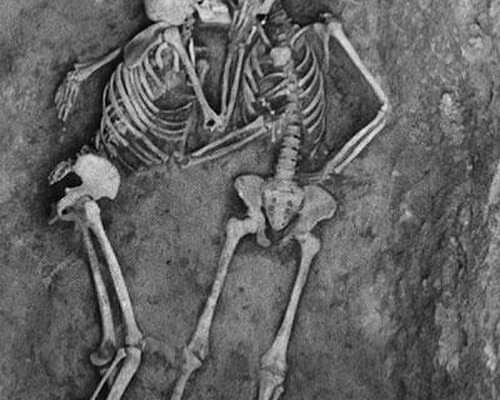Nestled in the Solduz Valley of Iran lies Teppe Hasanlu, an ancient city that whispers tales of a bygone era. In 1973, amidst the meticulous work of archaeologists from the University of Pennsylvania, a discovery unlike any other sent ripples through the scientific community – the “Hasanlu Lovers.” Two skeletons, locked in an eternal embrace, had been unearthed, their final moments frozen in time for over 2,800 years.
The scorching Iranian sun beat down on the excavation site as the team, led by Dr. Robert H. Dyson, meticulously brushed away layers of history. They were nearing the end of the dig season, unearthing remnants of a once-thriving civilization tragically cut short. Then, within a mudbrick and plaster storage bin, a sight unlike any other unfolded. Two complete skeletons lay intertwined, their positioning sparking immediate intrigue.
One skeleton, possibly male due to its slightly larger size, cradled the other in a protective embrace. The other, possibly female but lacking definitive markers, leaned into the embrace, their skulls seemingly tilted towards each other in what some interpreted as a kiss. The image was poignant – a testament to a love that defied even the ravages of time.
News of the discovery spread like wildfire. The “Hasanlu Lovers” became a media sensation, their story a beacon of romance amidst the harsh realities of the ancient world. The public imagination ran wild, painting a picture of star-crossed lovers who perished together.
However, archaeologists remained cautious. While the positioning was undeniably evocative, the exact nature of the relationship – romantic or otherwise – remained a mystery. “Lovers, friends, or strangers?” pondered the Penn Museum’s Expedition Magazine, highlighting the limitations of skeletal remains in definitively establishing such a bond.

Further analysis revealed a grimmer picture of their final moments. The city of Hasanlu had been ravaged by a violent attack, likely around 800 BCE. The skeletons bore witness to the brutality – both individuals had suffered trauma, though not necessarily fatal blows. The most plausible explanation was that they had sought refuge in the storage bin, only to succumb to smoke inhalation from the raging fires that engulfed the city.
The cause of death, however, did little to diminish the power of the image. The embrace, interpreted by some as a final act of comfort or a desperate clinging to life, resonated with a universality that transcended cultures and millennia.
The discovery also offered a glimpse into the lives of ordinary people caught in the throes of war. Were they a married couple? Parents seeking solace in each other’s arms? Siblings offering desperate comfort? The lack of definitive answers fueled the intrigue, allowing each observer to project their own interpretation onto the timeless tableau.
The “Hasanlu Lovers” currently reside at the Penn Museum, a poignant reminder of the enduring power of human connection. While their story may be shrouded in the mists of time, their final embrace serves as a powerful symbol of love, resilience, and the enduring human spirit in the face of tragedy.
The discovery continues to spark debate and inspire artistic interpretations. Sculptures, poems, and even a song have been dedicated to their memory, ensuring their story lives on for future generations.
The “Hasanlu Lovers” stand as a testament to the enduring power of human connection. They remind us that love, in its many forms, transcends time and circumstance. Even in the face of unimaginable violence, their final embrace offers a flicker of hope, a reminder that the most basic human emotions – love, comfort, and the desperate clinging to life – echo through the ages.



